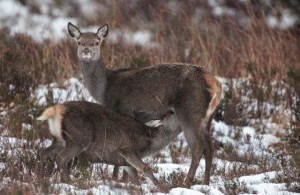 Just as with the red deer stags the hinds are at a low ebb at this time of the year. The rut last autumn had little affect on them as it is the stags that do all the demonstrating and very occasional fighting. It is almost as if the hinds throughout the rut are bored with the whole proceedings. Despite what the artist Edwin Landseer implies with his classic portrait of a stag entitled “Monarch of the Glen” it is a matriarchy. The hinds dictate what is happening all the year round as it is the stags that keep trying to locate them. Once the rutting season is over in the Autumn the hinds re-group into herds dominated by hinds with only a few very young stags amongst them. The hinds stay in such herds for the rest of the year until the rut in the following autumn. Sometimes the herds are very large, running into hundreds, and they occupy very large areas of countryside with the stags elsewhere. Such areas are known as “hind forests” although this is a misnomer as much of it will be open hill with very little, if any, woodland.
Just as with the red deer stags the hinds are at a low ebb at this time of the year. The rut last autumn had little affect on them as it is the stags that do all the demonstrating and very occasional fighting. It is almost as if the hinds throughout the rut are bored with the whole proceedings. Despite what the artist Edwin Landseer implies with his classic portrait of a stag entitled “Monarch of the Glen” it is a matriarchy. The hinds dictate what is happening all the year round as it is the stags that keep trying to locate them. Once the rutting season is over in the Autumn the hinds re-group into herds dominated by hinds with only a few very young stags amongst them. The hinds stay in such herds for the rest of the year until the rut in the following autumn. Sometimes the herds are very large, running into hundreds, and they occupy very large areas of countryside with the stags elsewhere. Such areas are known as “hind forests” although this is a misnomer as much of it will be open hill with very little, if any, woodland.
However, as with the stags, the hinds have still had the problem of finding enough food in the winter months and if it is a bad winter there may well be great mortality. Now the hinds are looking forward to the first bite of spring grass and other plants so they can build themselves up to cope with the calving season which may well begin in May or at the latest June. For calving the hinds will go to a quiet corner but then they tend to move to much higher ground for the rest of the summer. The red deer hind is a very protective mother and will watch over the calf non-stop. Look how wary the hind in the photograph is as her calf feeds. However, there is one saving that they have and that is each hind will keep an eye on all the calves, especially where a hind has wandered away from her calf to feed. Sometimes the hind may be some distance from her calf but she knows there is always one hind on the lookout for would be predators such as foxes or even golden eagles. Red deer, unlike roe deer that often have twins, normally have only one calf and twins are very rare. I can only recall ever seeing two different sets of twins in red deer the whole time I have watched them and indeed stalked them. One of my favourite pastimes many years ago was to climb way up in the hills and listen to the calves “talking” to each other in the half light of the mid-summer night – sheer magic.
The calving is the most vulnerable time of the year for both the hinds and their calves. The hinds are generally not bothered by predators as few foxes would dare attack an adult. There are stories about golden eagles forcing hinds off a cliff to fall to their death, or injured, below. There is an account of an eagle doing that on the Isle of Rum and it is difficult to doubt as the observer was a very experience stalker. So it seems it can happen but perhaps only with a hind that is not fit or unwell. Calves are a different matter despite the diligence of the hinds. Golden eagles, foxes and now presumably sea eagles, will take calves if the opportunity presents itself. Once the calf, or rarely a hind, is dead then many types of carrion descends on the carcase. There is one well known record of the warden in Glen Strathfarrar coming around a high corrie and seeing a badger, in the middle of the day, feeding on a dead
